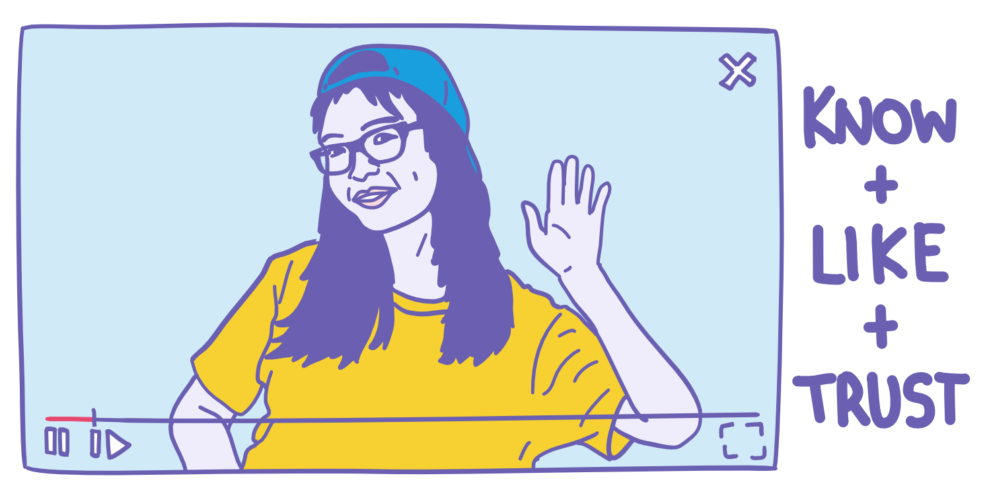Struggling to increase sales? Get in front of a camera to build an audience that knows, likes, and trusts you.
Think about the last product you purchased.
Whether it was a breakfast burrito, piece of software, or bundle of toilet paper, I bet I can guess three things about the relationship between you and the company that sold it to you:
- You knew the brand — even if this was a first-time purchase, you were familiar with the company.
- You liked the brand (or, at the very least, you disliked competing brands more).
- You trusted the brand enough to hand over your money.
How’d I do?
If you’re impressed, you should know that my guesses aren’t based on psychic intuition or a supernatural fortune-telling ability. (So, no — I can’t predict winning lottery numbers for you. Sorry.) I’m simply aware that people tend to do business with companies they know, like, and trust.
This idea has existed in sales and marketing for pretty much as long as sales and marketing have existed. In this blog post, we’ll explore the basics of the know, like, and trust (KLT) factor and how to grow yours using video.
How can the KLT factor increase sales?
In industries of all kinds, competition has arguably never been as fierce as it is today. It seems as though for every product on the market, at least two or three interchangeable alternatives exist.
So, how can you make your business stand out among the homogenous wash of sameness? How do you differentiate yourself and earn the attention of people?
One of the most effective ways, I think, is with video — specifically, video featuring you. After all, it’s the perfect medium for building awareness (know), affinity (like), and credibility (trust).

Step 1: Let people get to know you
Before anyone can like or trust you, they have to actually know who you are. And this first step may be the most challenging.
After all, your greatest competition isn’t another company in your industry. It’s the countless distractions fracturing the focus of your ideal audience.
So, how do you get people to pay attention and not abandon you for cat videos or social media notifications? Here are a few ideas, assuming you’re starting from scratch and don’t already have a loyal audience.
Create relevant, valuable content
If you want people to give you a slice of their precious time, you must give them a reason to. That seems obvious when I write it. But the internet is drowning in navel-gazing content.
As a result, if you create videos that directly improve your viewers’ lives in some way, you’ll already be ahead of the vast majority of the flotsam drifting around the web. Because people will naturally want to watch what you make out of self-interest.
You can blame survival instinct. But we’re all wired to see the world in terms of “what’s in it for me?” to an extent — whether we’re aware of it or not.
So, how do you create content that improves viewers’ lives and garners attention?
That’s ultimately going to depend on your industry, product, and audience, among other things. But one of the most reliable ways is to share what you know — to lean on your own expertise.
For example, I worked as a content marketer for seven years. So, on my YouTube channel, I often draw from that experience to teach my viewers how to make their video ads more effective.
That being said, your videos don’t have to relate to business. The gift you give viewers could be as simple as a laugh — a humorous escape from the daily grind — as the Harmon Brothers often provide in their commercials.
Publish on the right platform(s)
You’ve probably heard before that YouTube is the second largest search engine on the web next to Google. So you may assume it’s the best place to publish your videos. But whether that’s actually true depends on the kind of videos you make and, more importantly, where your audience hangs out.
For instance, if you’re shooting daily vlog-style videos in portrait mode on your iPhone, you might get better results posting them as Instagram Stories rather than as YouTube videos… unless your key audience is retirees. Because people aged 65+ make up the app’s smallest user group (2%).
My point is that your audience won’t notice you if you’re publishing your videos on platforms they don’t use. So the smartest approach is to research and experiment until you find out which channels deliver the most worthwhile results.
And when you do publish, make sure you’re following these social media video best practices.
Tell a story
People are obsessed with stories. Just think about how much of your time is spent either consuming or telling them.
Movies, television, podcasts, books, and even the majority of our conversations center around stories.
So should your videos — assuming you want them to engage and entertain your audience. Because story has been the vehicle for sharing information for thousands of years. And as a result, our lizard brains are addicted to it.
Storytelling is too large a topic for me to cover in detail in this post. Fortunately, I’ve already written about it over here: How to tell better stories with your videos »
Pro tip: To make your stories more compelling, introduce cliffhangers.
Create emotional appeal with music
Research shows that videos get more attention when they’re steeped in emotion. And by cueing your audience to feel joy, sadness, excitement, and other moods, music can be a subtle but effective way to make your videos more emotional and, therefore, more attention-grabbing.
If you need a primer on using music in your videos, check out these posts:
- The 5-Part Process of Picking the Perfect Music for Your Video
- How to Add Music to Your Video (for Free)

Step 2: Encourage people to like you
When was the last time you bought something from a company you didn’t like — just because they got your attention? (OK, internet providers don’t count. Sometimes you have to choose between bad and worse.)
Making prospects aware of your company or product isn’t enough to increase sales. You must also connect with people in a favorable way.
In other words, you need your audience to like you.
By showcasing the personalities of you and your team, video allows people to decide whether they like you.
What people prefer will always be subjective, of course. But here are a few ways you can increase the odds of folks becoming your fans.
Provide free value
You’re not having déjà vu.
We already looked at how offering value can attract attention. But there’s another perk of creating content that benefits your audience: It triggers a psychological effect known as the rule of reciprocity.
Popularized by Robert Cialdini (I’m going to reference Cialdini quite a bit in this post, as he wrote the book on influential marketing psychology… literally), the rule suggests that people feel obligated to repay gifts.
So if you give your viewers the gift of a better life in some way — whether that’s through cooking tips or tax advice — they’ll be inclined to return the favor, often in the form of supporting your business.
Add uplifting background music
OK, now I’m just feeling redundant. But research has shown that — in addition to making your videos more attention-grabbing — using music in your videos can increase your brand’s likability.
For example, one study played three versions of a soap commercial to 200 participants. The only difference among the versions was the background music.
Commercial A had a positive song (e.g., major scale and faster tempo), commercial B had a negative song (e.g., minor scale and slower tempo), and commercial C had a neutral song.
As you might expect, the participants who watched commercial A expressed a more favorable opinion of — and a greater willingness to buy — the soap compared to the other participant groups.
The takeaway? In most cases, adding cheerful-sounding music to your videos may help you make a better impression on your viewers.
Serve members of your tribe
Here’s another revelation psychologist Robert Cialdini has shared in his books: We tend to like people who are similar to us.
That’s not terribly shocking, of course. Just consider the people you hang out with. You likely share something in common with them — whether that’s a hobby or a worldview. Even something as superficial as similar names can trigger the liking effect.
You can use this psychological tendency to your advantage by aiming to serve people who are similar to you. The efficacy of this tactic is likely a key reason we’re beginning to see a lot more movement- and value-based brand positioning, especially as most industries become commoditized.
For instance, backpackers love Patagonia because the company actively works to protect the planet, and thereby demonstrates a commitment to environmentalism — a value most of its target customers likely share.
This example and others like it actually transcend mere similarity and create a sense of what Cialdini calls “unity” — the feeling that a person or entity is not just like you, but of you. In other words, they’re part of your tribe.
We can attribute the intense degree of dedication and conviction present in religion, politics, race, and nationality to this phenomenon. The feeling of unity creates a sense of “confused self,” tricking your brain into thinking you’re acting in self-interest when you’re actually acting for the sake of others in your tribe.
So, when you’re making videos, keep people who are similar to you in mind.
Ask for a favor
If you want someone to like you, you should do things for them without expecting anything in return, right? Though selfless action may seem like the right approach, the Ben Franklin Effect suggests otherwise.
This effect describes the psychological phenomenon of people liking you more when you ask them for a favor. The effect was named after a story about — you guessed it — Ben Franklin.
The story goes that Franklin asked to borrow a book from a rival. And upon returning it with a thank you note, he and the man became lifelong friends.
This effect has since been replicated in various studies. However, its root cause is the subject of debate. Some attribute it to cognitive dissonance. (Basically, we can’t rationalize helping someone we dislike. So we decide that we must like them since we’re helping them.)
Others propose that when you ask someone for a favor, it signals to that person that you want them as a friend. And in response, they reciprocate the positive feelings they think you have for them.
Regardless of why it works, my point is that asking your viewers to do something for you can actually increase affinity.
So, what kind of favors could you request? Try asking viewers to like your video, subscribe to your channel, leave a comment, support you through a platform like Patreon, or share your video on social media.
Pro tip: Many of these “favors” — particularly the last — will also increase your video’s visibility, helping you with step one (becoming known).
Pay a compliment
To borrow yet another idea from Cialdini: We’re inclined to like people who compliment us, even if we know the complimenter has ulterior motives.
It may feel a little unnatural to pay your audience compliments in a video. But I think it does make you seem more approachable and human.
I’ve noticed YouTuber Jake Roper often does this at the beginning of most of his videos. He’ll say things like, “hello, you magnificent creature,” and “you look as dashing as ever.”
Obviously, Jake doesn’t know how I — or any of his viewers — actually look. It’s an empty compliment. Regardless, it makes him seem like a friendly, likable person. And that’s what you’re going for, right?

Step 3: Give people a reason to trust you
So you’ve caught someone’s eye and made her like you. Well done.
But now you need to convince her that you’re legit. Because if she doesn’t feel safe with you, she’s not going to pull out her credit card.
Use the following techniques to enhance your credibility and earn your audience’s trust.
Be real and vulnerable
People want to do business with other people, not faceless corporations. That’s at least one reason many companies, especially startups, have begun to embrace cultures of transparency and authenticity.
Honesty can be a little uncomfortable, however, since you’re exposing your failures as well as your successes. But according to Cialdini (I warned you I’d reference him a lot), this should make you seem more trustworthy, not less. It implies that you aren’t hiding anything. Which is good considering uncertainty is a purchase-killer.
Pro tip: For maximum effect, you should acknowledge a minor drawback, and quickly follow it with “but,” or “yet,” and a benefit. Doing this diminishes the importance of your weaknesses and shifts attention to your strengths.
How could this translate to video? Try starting a vlog-like series that offers an authentic view of daily life at your company.
Demonstrate authority
If you were trying to remedy a sore throat, whose recommendations would you trust and follow — those of a doctor, or those of your neighbor?
People trust people with titles, mostly because titles imply experience and third-party validation. After all, you typically must earn a title through hard work and dedication to the subject of your specialty.
So if you’re a certified dog trainer, flaunt that fact. But also be sure to back it up by sharing expert-level dog training content in your videos.
Showcase social proof
In times of uncertainty, we look to others to decide what our own behavior should be. Such is the law of social proof.
Why do you think the average Amazon product listing features the following sections?
- “Frequently bought together”
- “Customers also search for”
- “Customers recommend”
- “Customer reviews”
Amazon knows that you’ll likely be influenced by the actions of other people. And Amazon’s not the only one.
Do you look at like counts when deciding who is worth following on Instagram? Do you consider ratings on Yelp when deciding where to eat? Do you heed celebrity endorsements when deciding what to buy?
Nearly every successful business uses social proof in some capacity. And you can, too, in your videos. The simplest way is by sharing customer testimonials.
Bonus points if you can get your customers to share their testimonials as stories by describing:
- Their lives before your product (e.g., the problem your product solves)
- What made them decide to purchase the product
- How their lives are different with the product
Deliver consistently
Have you ever had a flaky friend? Someone that promises to be somewhere or do something, but then… no show.
I don’t know about you, but I don’t rely very heavily on people that act inconsistently or can’t seem to follow through.
Flaky businesses aren’t much different. Most people are put off by an unpredictable brand experience. (After all, “inconsistent brand” is kind of an oxymoron.)
To avoid this, make sure your videos maintain a standard of quality and publish them on a regular schedule. It can also help to repeat elements (e.g., intros, graphics, music, people) in each video.
In summary…
Whew! That was a hefty post. Thanks for sticking with me. To wrap up, let’s quickly review how you can use video to increase sales.
1. Increase audience awareness (know):
- Create relevant, valuable content
- Publish on the right platform(s)
- Tell a story
- Create emotional appeal with music
2. Create brand advocates (like):
- Provide free value
- Add uplifting background music
- Serve members of your tribe
- Ask for a favor
- Pay a compliment
3. Grow brand credibility (trust):
- Be real and vulnerable
- Demonstrate authority
- Showcase social proof
- Deliver consistently
Want more marketing psychology tips?
If you’re hungry for more business-boosting tips, check out my post on using emotional, logical, and physical appeals to make your product videos more likely to win new customers.

